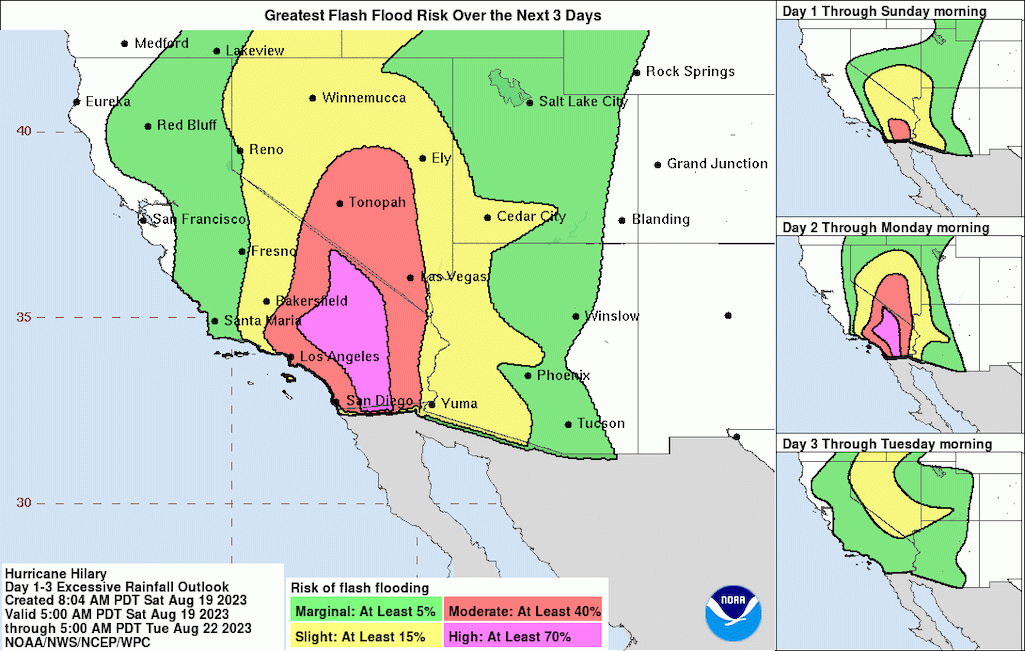
Storm clouds over Lake Mead on Saturday/NPS
Editor's note: This updates with Lake Mead NRA closing.
With the prospect of "catastrophic" flooding in the forecast, Death Valley and Joshua Tree national parks, along with Mojave National Preseve and Lake Mead National Recreation Area, braced Saturday for the arrival of Tropical Storm Hilary.
Josha Tree, Mojave Preserve, and Lake Mead all closed ahead of the brunt of the storm, while Death Valley's campgrounds and the Furnace Creek Visitor Center were closed. Cabrillo National Monument west of San Diego was to close Sunday and Monday, while Manzanar National Historic Site near Lone Pine, California, was to close Sunday due to the storm.
In these desert Southwest parks, where annual rainfall ranges from 2.2 inches at Death Valley and 4.4 inches at Joshua Tree to 3.5 inches in lower elevations of Mojave Preserve, Hilary was threatening to bring 6 inches or more of rain by Sunday night into Monday. "Dangerous to catastrophic flooding is expected," the National Hurricane Center predicted.
The first finger of flooding at Death Valley was reported Saturday afternoon from the western portion of the park, near the park entrance at California 190, milepost 45, park spokeswoman Abigail Wines said in an email, though she had no details of how bad it was.
The storm was expected to not only disrupt travel in Death Valley, but possibly lead to power outages and affect Internet and cellphone service.
Wines said there's a "good chance" the flooding will surpass that which the park experienced last summer, when a series of flash floods pounded the park, tearing up water lines, eroding roads, partially burying vehicles in debris, and closing much of the park. One storm dropped nearly 1.5 inches of rain in a matter of hours.
"The Oasis at Death Valley has done some sandbagging at The Inn. They're having people park elsewhere than the lot that flooded badly last year," said Wines. "NPS is sandbagging a couple employee houses that flooded last year, but mostly, sandbags won't do much for what we're facing."
At Mojave National Preserve, the National Park Service was particularly concerned about flooding because of the recent York Fire.
"As the York Fire burned through Mojave National Preserve, it removed the already sparse vegetation, decreasing the soil’s ability to absorb water and increasing the capacity for water flow to cause more damage," preserve staff noted in a social media post. "The preserve’s infrastructure was built to sustain rain events before the York Fire changed the landscape. This has made structures like roads, buildings, and culverts more vulnerable in post-fire rain events. Culverts in the preserve may be unable to manage the amount of water during a heavy rain event; causing roads to flood with debris, buckle and become undercut. This creates unsafe or impossible travel conditions."
On its website the park staff warned of "a hazardous situation of flooded roads, missing roadway, debris on roads. Please do not drive around barricades or cones - Do not follow third party navigation applications into area."
At Lake Mead, the Park Service initially closed Temple Bar, Cottonwood Cove, Cottonwood Cove East, Nevada Telephone Cove, Christmas Tree Pass, Willow Beach and Eldorado Canyon, Hemenway Harbor and the Callville Bay Complexes, before implementing the full park closure. The park also reported that it "has already experienced multiple power and utility outages prior to the arrival of Hurricane Hilary. Due to a storm last night, one marina experienced extensive damage, including multiple dock separations, power outages, and fuel outages."

A National Hurricane Center graphic predicted flash floods for Joshua Tree, Death Valley, and Mojave National Preserve/NOAA

 Support Essential Coverage of Essential Places
Support Essential Coverage of Essential Places



